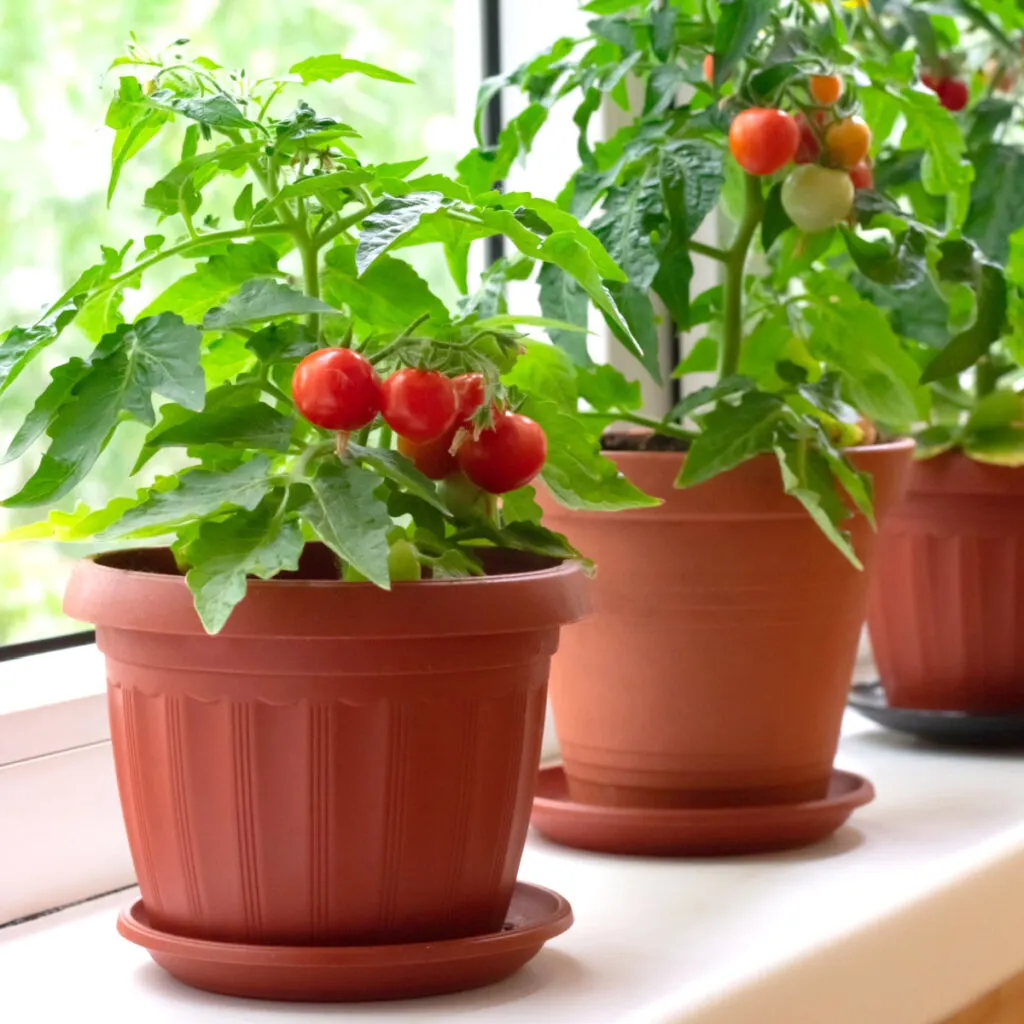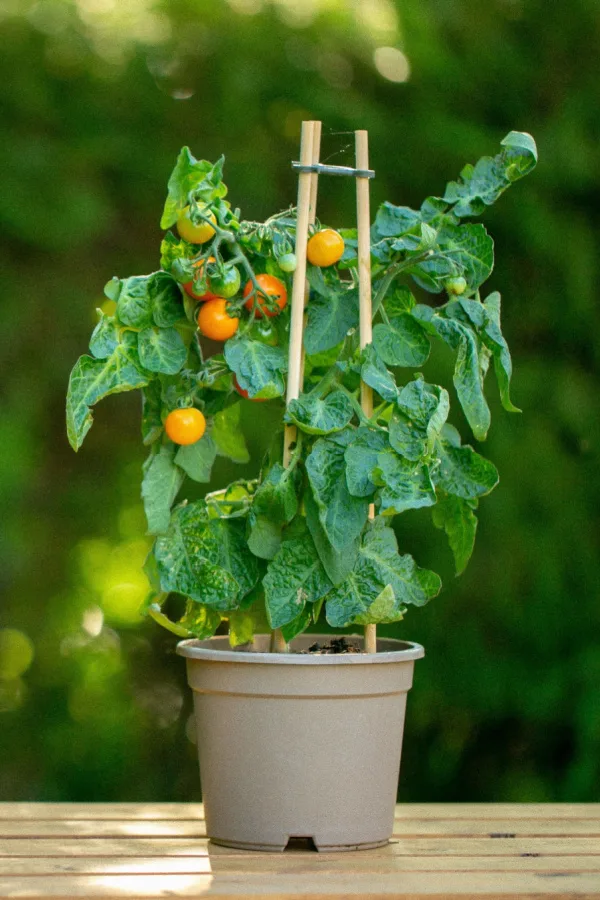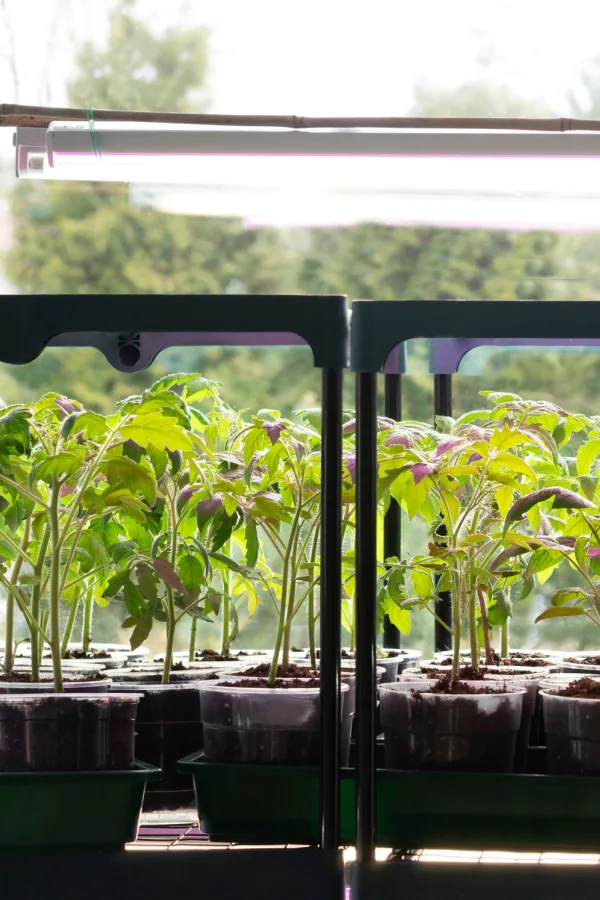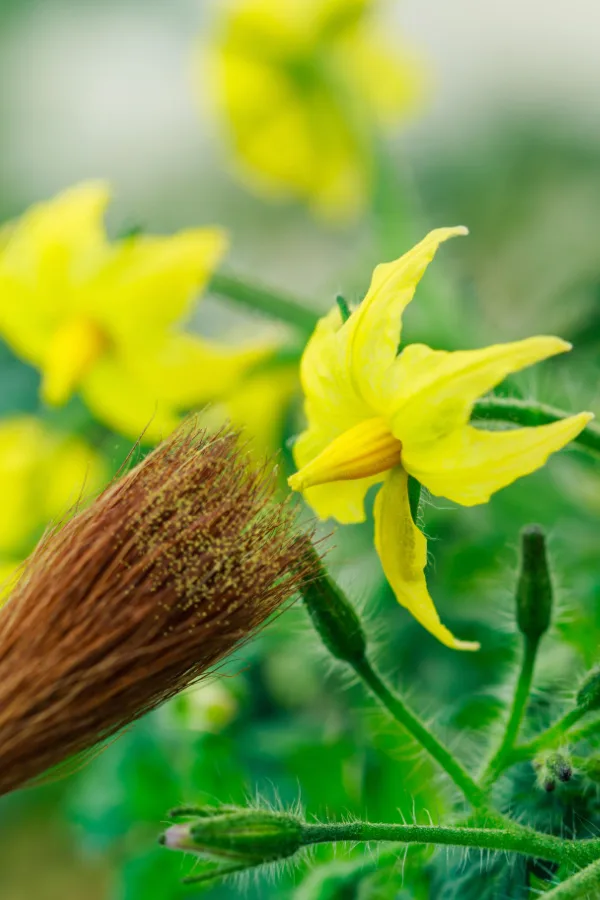Growing tomato plants indoors is a great way to extend your growing season and enjoy ripe, juicy tomatoes all year long. Just imagine how nice it would be to walk to your spare room and harvest fresh tomatoes whenever you want!
You’ve probably heard of people growing lettuce and other leafy greens indoors during the winter season. Maybe even a few radishes or some microgreens thrown into the mix.
But did you know that you can grow tomato plants indoors as well? While you likely won’t have much success growing huge meaty slicing tomatoes, you can enjoy growing several different varieties and flavors of dwarf or patio tomatoes – All from the comfort of your own home.

Dwarf or patio tomato plants are varieties that were created to be more compact and bush-like in growth. Most are determinate varieties, which means they push out all of their fruit at the same time for quick and easy harvesting.
When you grow tomato plants indoors, you have much better control over the growing conditions and you don’t have to worry about the usual pests and diseases. In addition, by saving the seeds of heirloom plants, you are guaranteeing that you have access to homegrown tomato plants for years to come!
Tomato Varieties To Choose
You can attempt to grow any tomato variety indoors. However, you will have the best luck with dwarf or patio varieties. These compact plants are perfect for fitting on shelving units or tabletop stands. Not only do they take up way less space than larger vining tomatoes, but they also require little to no support as well.
You can even find dwarf tomato varieties that only grow up to a foot tall. That’s a huge plus when you are trying to grow indoors in a limited space. At that small size, you can fit a ton of plants in a tiny space – resulting in bigger harvests for you overall! (Affiliate Product Link: Tiny Tim Tomato Seeds)
Growing smaller, compact plants will also allow you to practice succession planting. This helps to ensure you have a constant supply of fresh tomatoes on hand. (See, “Succession Planting – How To Get The Most From Your Garden Space!“)
How To Grow Tomato Plants Indoors
When growing tomato plants indoors, you need to replicate the conditions of the outdoors as much as possible. This includes sunlight, wind, watering, and pollination.

Choose a warm location within your home that is away from drafts and heater vents. You don’t want to be moving the tomato plant around, so pick a location where the plant can grow undisturbed.
In addition to choosing a good location, you need just a little bit of supplies to get you started. Most all of the supplies needed will be similar to those used for starting seeds indoors.
Starting Tomato Seeds
The best way to grow tomatoes indoors is to start the plants from seeds. Not only can you purchase an entire packet of seeds for relatively cheap, but you have more varieties to choose from than if you were to purchase tomato starts from a nursery. (Not to mention that many garden nurseries don’t carry vegetable starts in the fall and winter months.)
Use containers that have drainage holes and are around 3 inches wide by 3 inches deep. Fill the container with pre-moistened seed starting soil. Add 2 to 3 seeds per container and lightly cover with additional soil. Keep the soil moist but not saturated.
Once the tomatoes have germinated, place the containers under artificial lights. You don’t have to purchase specific “grow lights” to grow plants indoors. In fact, basic shop fluorescent or LED lights work perfectly well and are much less expensive.

Keep the lights only a few inches above the seedlings. If the lights are spaced too far above, the plants will end up thin and leggy. Move the lights up as the plants grow taller, always keeping just a few inches between the plants and the lights.
Transplanting Seedlings
When the seedlings have two sets of real leaves, thin so there is only one plant per container. Once the seedlings reach about 6 to 10 inches tall, you need to move them into bigger containers. Ensure that the container you choose has plenty of drainage holes.
The size of the container you choose will depend on the mature size of your tomato variety. Some dwarf varieties that grow less than a foot tall only need a 6 to 8-inch container. However, bigger patio varieties need a container that is at least a foot wide and several inches deep.
Fill the container with an all-purpose potting soil mix. To give the tomato plants a great boost of energy and nutrients, mix in a little bit of compost before adding the tomato transplant. (Affiliate Product Link: Espoma Organic Potting Soil)
If your tomato variety will grow to be over a foot tall, add a support of some sort. A thin piece of wood or dowels works perfectly for smaller patio varieties. Lightly tie the plants as needed to the stick to help keep the plant growing upright.
Growing Tomato Plants Indoors
Tomato plants need at least 6 to 8 hours of direct sunlight each day, whether that is artificial lights or sunlight. Continue to maintain only a few inches between the tomatoes and the lights as the plants grow.

In addition to artificial light, keep the soil moist but not saturated. Tomato plants that are grown indoors will need to be watered more frequently than those that are planted in the ground. Allow the top inch of soil to fully dry out before watering again. Drain off any excess water.
Tomato plants are heavy feeders. Since there is only a limited amount of nutrients in potting soil, you need to give each plant fertilizer. Apply half a dose of all-purpose liquid fertilizer every two weeks for indoor tomato plants. (Affiliate Product Link: Espoma Organic Tomato Fertilizer)
Pollinating Indoor Tomato Plants
Tomatoes are considered to be self-pollinating. Because of this reason, you don’t need bees and butterflies to help pollinate blooms to create tomatoes. However, you do need to give your plants a little help when it comes to pollination to have the best success.
One way to do this is to set up a small, oscillating fan that points directly at the tomato plants while there are blooms. The fan will help to circulate the air and move the pollen from bloom to bloom. The fan is also beneficial in preventing stagnant air, which can bring about mold issues.
Another way to help assist with pollination is to lightly shake the plants occasionally. Once or twice a day while the tomato plants are in bloom, gently shake the plant back and forth.

Lastly, you can hand-pollinate each bloom. To do this, take a small clean brush or q-tip and collect pollen from one bloom. Move to the next bloom and do the same thing. As you go from bloom to bloom, the pollen will be transferred between the blooms.
Harvesting & Saving Seeds
Once your tomato plant starts to produce fruit, harvest often to encourage additional growth and blooms. If you are growing heirloom tomato varieties, save their seeds so you can continue to grow new tomato plants – whether indoors or outside. (See, “How To Save Heirloom Tomato Seeds”)
By growing tomato plants indoors and then saving their seeds, you can ensure that you can have fresh, ripe tomatoes year-round no matter what season it is!
Follow Our Facebook Page For Even More Great Tomato Growing Tips! I Grow Tomatoes Facebook Page
I Grow Tomatoes is a website created for those who love all things about tomatoes – from planting and growing – to cooking and canning! We publish two articles every week, 52 weeks a year. Sign up today to follow via email! This article may contain affiliate links.
